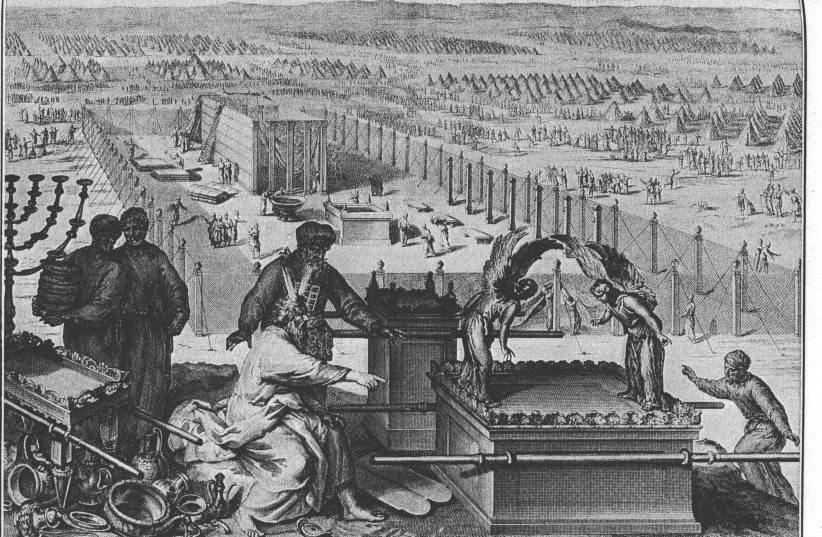The sages explained that both Moses and David did apprenticeships as shepherds. Since they looked after their sheep with care and individual attention, the Almighty decided that they had the necessary temperament to lead the Jewish people (Exodus Rabbah 2:2).
In his Degel Mahaneh Efrayim, Rabbi Moshe Hayim Efrayim of Sudilkov (1742- or 1748-1800) cited this tradition and added a proof text. Moses’s role as a shepherd is first mentioned in the verse: “And Moses would tend the flock of his father-in-law, Jethro, the priest of Midian, and he led the flock far away into the desert, and he came to the mountain of God, to Horeb” (Exodus 3:1). The Degel highlighted one Hebrew word in the verse: “hamidbar” – the desert. Torah scrolls are written without vowels, so the Degel suggested that the word could be read as hamedaber – the one who speaks. Since Moses had proven himself as a good shepherd in the desert, God chose him to serve as a shepherd for those endowed with the power speech.
The Degel’s interpretation relied on the notion that there is a license to read a string of letters with vowels that are different than those assigned by tradition. Elsewhere in his volume, the Degel opened a teaching by referencing this method as a principle of Bible interpretation: “For the Torah was given without vowels, and it is possible to expound [the text] with any vowels that are appropriate for the matter of the sermon.” After stating the rule, the Degel launched into a brief dissertation on the primacy of honesty:
“For all the troubles that befall a person – Heaven forfend – are a result of being drowned in falsehood and not cleaving to the truth, such that a person’s mouth and heart are not on par. But a person who cleaves to the truth and that person’s mouth and heart are in harmony – then all the harsh judgments are sweetened.”
According to the Degel, the first step to improvement is to avoid dissonance between the mouth and the heart. If the mouth would only speak what was truly in the heart, then a person could focus on sweetening the root of negative speech; that is, sweetening the heart.
To ground his contention, the Degel cited a biblical verse from the Exodus story. Just before the Children of Israel left Egypt, Moses relayed God’s instructions and promised that when they would leave, no dogs would bark at them: “And against any of the Children of Israel, a dog shall not sharpen its tongue” (Exodus 11:7). By changing the punctuation of the sentence and the vowels of the Hebrew word for dog, “kelev,” the Degel saw this verse as proof of the demand that people’s hearts and mouths should be in accord: And against any of the Children of Israel, nothing shall be sharpened, because one’s tongue should be k’lev, like the heart.
Elsewhere in his work, the Degel offered a broader perspective on this interpretive method:
“For this is certain and true, for the Torah was given without vowels, and the reason is that the Torah has 70 faces, and the Torah is to be interpreted by means of the vowels that are relevant to the subject of the sermon... and it is possible to punctuate the Torah with whatever vowels are desired so that the matters of the sermon emerge nicely.”
Thus the intentional lack of vowels in the Torah scroll adds an element of elasticity to the text, and sets the stage for the gamut of 70 different interpretations.
A CONTEMPORARY of the Degel records a similar tradition of biblical interpretation, albeit in a distant land and different cultural context. Rabbi Hayim Yosef David Azulai (1724-1806), known by the acronym Hida, was born in Jerusalem. In 1755, he was chosen to be an emissary for the Jewish community of the Land of Israel, and his travels took him to distant lands.
The Hida was a bibliophile, and during his extensive travels he examined collections of books and manuscripts and visited famous libraries. He made notes of what he saw and which rabbinic figures he encountered. The breadth of the Hida’s scholarship is breathtaking, and he was prolific writer, bequeathing an impressive range of books.
One work, LeDavid Emet, is dedicated to the laws of Torah scrolls and was printed in Livorno in 1796. The volume draws on previous works, though the Hida added his own ideas. In one passage, the Hida cited the tradition that Torah scrolls do not include vowels so that people can interpret the text as they wish.
He also cited his colleague, Rabbi Avraham Hayun of Jerusalem (d. 1800), who had explained that the original Torah was just a heap of holy letters before the Almighty. In order to give those letters to the physical world, God organized them into words that reflected temporal reality. Torah scrolls do not include vowels, punctuation or cantillation marks as a reflection of what original, spiritual Torah once was.
Hayun went a step further with his explanation. In the End of Days, God will take those very same letters and reorganize them into different words that relate to the new messianic reality. In this way, the letters of Torah are eternal, even though the words they form, their vowels and pronunciation, and the way they are strung together to form sentences change.
Thus, the legitimacy of reading words with vowels that differ from the traditional reading appears in sources that are contemporaneous with the Degel. Both the Hida and Rabbi Hayun of Jerusalem were unconnected to developments in Eastern Europe. Bringing these sources together reminds us to situate Hassidism as a part of the mosaic of Jewish heritage.
The license to reinterpret the biblical text by transposing the vowels is a potent, perhaps even dangerous tool. Thus a caveat is order: Despite offering different readings by changing the vowels, none of the commentators suggested using this interpretative tool to change Jewish law. In this sense, the method was employed in a conservative manner: expanding the breadth of meaning without shaking the foundations of Halacha.
The explosive potential exists, though it has been pressed into service in the field of interpretation and as part of the evergreen quest for meaning. The mechanism has not been used to redefine communal norms or to recalibrate Jewish law. ■
The writer is on the faculty of Pardes Institute of Jewish Studies and is a rabbi in Tzur Hadassah.

